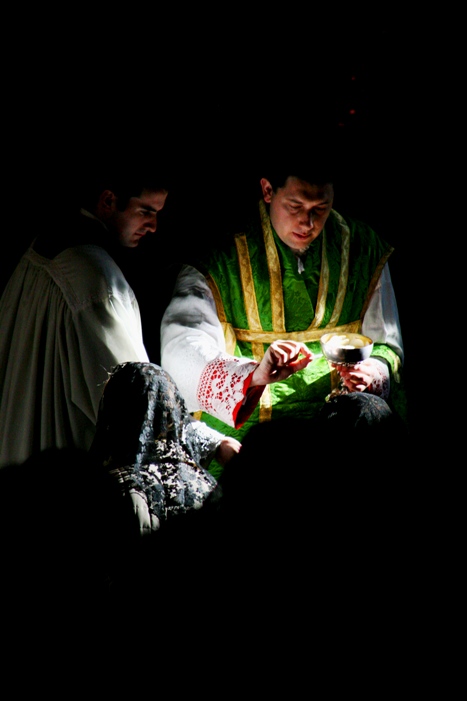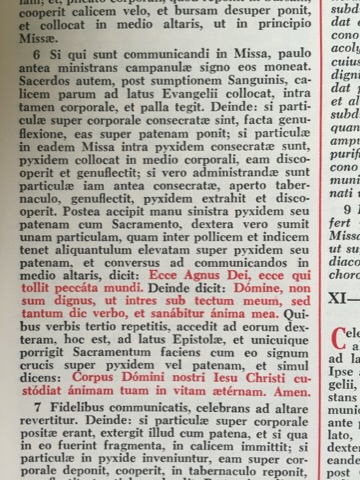 From a reader…
From a reader…
QUAERITUR:
I was told by a reverent, well-formed priest who celebrates the old Mass well and often that the formula for distribution for communion is not specified in the missal. [Ooops!]
He showed me that in the altar missal itself, there IS no ritual for distribution of communion to the faithful and said that when it became common practice for people to receive communion during Mass the rite from the Ritual was adapted, some using the same formula the priest uses himself, and some using the response “Corpus Christi” which appears in the old Rituale as well as the new rite. [Ooops! No.]
It is therefore “perfectly correct”, he says, to say “Corpus Christi” when distributing communion in the old Mass. [No. Sorry.]
Is he correct? Or is there some sort of rubric or governing legislation specifying what the priest should say to communicants?
Father is to be commended for celebrating the Extraordinary Form often! I hope that often is public and growing in frequency.
That said…
No and Yes.
Father, God bless him, is not correct on this point. There are rubrics that govern this in the 1962 Missale Romanum.
The manner of distribution of Holy Communion in the Extraordinary Form is described in the 1962 Missale Romanum. Look in the front sections (the rubrics and calendar and so forth), in the section called “The Rite to be observed in the celebration of Mass”, the Ritus servandus in celebratione Missae, X, 6. The formula Corpus Domini nostri… etc. is to be spoken for each (unicuique) communicant. Here is the text with my emphases.
6 Si qui sunt communicandi in Missa, …. […. Skipping up to the point where Communion is distributed….] Quibus verbis tertio repetitis, accedit ad eorum dexteram, hoc est, ad latus Epistolae, [NB] et unicuique porrigit Sacramentum faciens cum eo signum crucis super Pyxidem vel Patenam, et simul dicens: Corpus Domini nostri Jesu Christi custodiat animam tuam in vitam aeternam. Amen. Omnibus communicatis, revertitur ad Altare, nihil dicens: et non dat eis benedictionem, quia illam daturus est in fine Missae. Si particulae positae erant super Corporale, extergit illud cum Patena, et si qua in eo fuerint fragmenta, in Calicem immittit. Deinde dicit secreto: Quod ore sumpsimus, Domine, etc., et se purificat, dicens: Corpus tuum, Domine, quod sumpsi, etc., et alia facit ut supra. Minister autem dextera manu tenens vas cum vino et aqua, sinistra vero mappulam, aliquanto post Sacerdotem eis porrigit purificationem, et mappulam ad os abstergendum.
Take note of uniquique. This is dative of unusquisque (unus + quisque – both elements are declined), meaning “to each one/communicant”.
“… and to each one he presents the Sacrament making with It the sign of the Cross over the ciborium or paten, also saying at the same time: Corpus Domini nostri Jesu Christi custodiat animam tuam in vitam aeternam.”
Here is a shot from my hand 1962 Missale Romanum. Note that we have a reversal of red and black for rubrics and texts to be spoken! In this case, Father, Say The Red – Do The Black!
Father is correct that in the Ordinary of the Mass in the Missale Romanum the manner of Communion for the faithful isn’t described. But it is in the Ritus servandus!
It is also correct that the method of distribution of Communion to the faithful, perceived as a separate rite, in its own right as it were, was incorporated in the rites of Holy Mass. There is a separate rite for distribution of Communion outside of Mass, found in the Rituale Romanum. This is useful for when, for example, the choir could not come down for Communion during Communion time in the Mass, but they would like to receive. After Mass they come to the rail and Father (or a deacon) can give them Communion using the rite in the Rituale.
Therefore, Father should correct his practice right away. The whole form is to be spoken for each communicant.



































“Take note of uniquique. This is dative of unusquisque (unus + quisque – both elements are declined), meaning “to each one/communicant”.”
This is good to know. A nearby priest of ours has also recently started celebrating a monthly TLM, and although he uses the correct formula for communion, he only says it once for about every two communicants, e.g., “Corpus Domini Jesu Christi custodiat animam tuam in vitam aeternam “.
I thought this practice seemed questionable at best, but it’s nice to have the documentation. Now…how to tell him delicately…
Oops, I forgot about the HTML tags. My example should have come across as something like this:
“Corpus Domini Jesu Christi *gives communion to one person* custodiat animam tuam in vitam aeternam *gives communion to another person*.”
I recently discovered this myself. The switch to “Corpus Christi” was made in April 1964; there’s a brief little mandate from the Sacred Congregation of Rites in the AAS. (Thus, if you have one of those 1964 Collectio Rittuum editions that’s almost the same as the 1961, watch out for that rubric, which is wrong for the E.F.)
Here’s a question: can a priest distribute the Precious Blood using the EF rite for distribution outside of Mass to someone suffering from severe celiac disease? (The EF rite appears to be much shorter than the OF.) Fr. Z has implied that the answer is “yes” in these pages before, but did not provide detail, and the first authorization for this that I could find dates to 1967. Thoughts?
Interesting. Our priest (FSSP) told us that it was permitted to say the formula once for two communicants when I asked him why he races through distributing communion. He has slowed down substantially, but it still seems a bit off that he often says the formula after he placed the host on the communicant’s tongue and is moving on to the next person. I’ve been tempted to not stick my tongue out until he has finished saying the formula for the previous person.
As Fr. Z often points out, “mix and match” is wholly inappropriate when it comes to celebration of the Mass. I may be able to provide the source of the questioner’s priest’s confusion that underlies his error. He is most likely remembering the interim “hybrid” (for lack of a better term) Mass that was celebrated in the wake of the Second Vatican Council until the promulgation of the Mass of Paul VI (about 1965 through 1970). During that period, much of the Mass of Pius V was retained (although the Prayers at the Foot of the Altar were extensively abridged and the Last Gospel was jettisoned almost immediately). Parts of the Mass were initially recited in Latin and parts in the vernacular (eventually the entire Mass was recited in the vernacular). One early change was the substitution of V. “Corpus Christi” / R. “Amen” for the form used in the Mass of Pius V. The rationale was that reception of the Our Lord fully and completely in the Eucharist called for an affirmative assent of the mystery of the Real Presence from the communicant rather than an invocation by the priest that the Body of Our Lord preserve (guard, lead) our souls into eternal life. The new form carried on when the full vernacular was introduced and incorporated into the Mass of Paul VI (AKA the “Ordinary Form”. Because some elements imply in their use of it a lack of legitimacy, I hesitate to use the term “Novus Ordo” despite evidence that Bl. Paul VI referred to it as such on at least one occasion.)
Most priests begin the formula while moving from one communicant to the next so they do follow the rubrics, it just might seem “off.” Communion takes far too long if the priest stood at each communicant for the whole prayer and blessing. Most of the time it seems the Sign of the Cross is made over the recipient and the prayer is finished at the recipient but begun immediately after the previous “Amen.”
We have at least one person in one congregation with which I assist who cannot receive the host at all. She would become very, very ill. So we distribute a celiac chalice with the formula modified and the communicant kneeling. The FSSP apparently does it, and I find that there are a potential host of problems, it is more problematic in our situation to ask for an indult. Chiefly, it would be difficult to convince anyone we actually need them to ask for one on our behalf, the powers that be largely being unfamiliar with the TLM. We do this at Mass; I have no idea if the above commenter meant at Mass or outside of Mass (the latter is odd since the Precious Blood cannot be reserved).
If we ever were to get Cardinal Sarah’s Appendix with Extraordinary Form options for the Ordinary Form, perhaps one possible idea is to allow the longer communion formula as an option, e.g., if it is a mass with a small congregation or a small number of communicants.
I don’t understand why people are in such a rush to get through communion distribution. Such an intimate moment for each person receiving, and people just want to get it over and done with.
Fr. Z is correct about the communion outside of mass also for the Extraordinary Form of the Roman Rite. Our choir occasionally comes to the rail after mass for one reason or another to receive and the priest uses a nice card (from Biretta Books) while at the altar, with a server still assisting.
http://i62.tinypic.com/10wqjjs.jpg
APX, I agree. One advantage of the communion rail is you get to kneel in silence before, and it is easier to linger afterward for a moment, as opposed to the usual “bank teller line” in the Ordinary Form where you feel to have to move on immediately.
Yes, granted, but when you have 200 or 300 people at Mass and one priest distributing Holy Communion, and that priest pronounces the formula with—shall we say—deliberation for each communicant, the seconds add up in a way that has consequences for, e.g., the parish schedule, small children in the pews, etc. One’s desire to linger with Our Lord is laudable, but everyone’s collective, seriatim lingering is a logistical problem.
The prayer during the distribution of Holy Communion in the Extraordinary Form is beautiful, both in brevity and in intent:
What priest would not want to pray this prayer for each of his parishoners at this part of Holy Mass where Jesus truly comes to and into the heart of each person receiving Him? In the many EF Masses I’ve been to in the last few years, the distribution of Holy Communion never seems long, nor is it unduly lengthy. Of course, that is entirely due to two things: (1) FSSP parishes where both priests distribute, in effect “halving the work load”; and (2) the size of the congregations and the manageable numbers of parishoners who present themselves for Holy Communion, whether there are two priests distributing or only one [no “mega-Masses” here!].
There’s an added bonus for the communicants, too, in the EF: those who receive first have the opportunity to make a lengthy and “leisurely” thanksgiving, and those who receive last have the opportunity to make a lengthy prayer of desire, longing, contrition, and reparation.